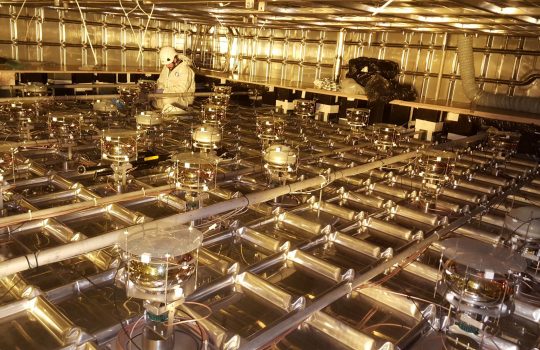The Deep Underground Neutrino Experiment, or DUNE, has brought together researchers from around the world to explore elusive neutrinos in the largest high-energy physics experiment in the U.S. The Spanish Centre for Energy, Environmental and Technological Research, also known as CIEMAT, is one of the key contributors to the international experiment.
A delegation led by Yolanda Benito Moreno, CIEMAT’s director general, recently visited the U.S. Department of Energy’s Fermi National Accelerator Laboratory, which hosts DUNE.
Since 2015, Spanish research groups have played a critical role in DUNE’s research and development phase. They are contributing to the ultra-sensitive liquid-argon detectors of DUNE. When neutrinos interact with the cryogenic liquid argon inside DUNE’s neutrino detectors, photons—particles of light—will be produced. CIEMAT researchers are developing a photon detection system that will be triggered by the interactions between neutrinos and liquid argon. The system will provide a complementary signal to the traditional ionization signal in liquid argon. In addition, the groups are creating a temperature-monitoring system to track the temperature of the liquid argon within the detectors more precisely.
On the first day of the visit, the CIEMAT delegation met with Fermilab’s leadership to sign a commemorative certificate to acknowledge the official partnership that went into effect in December 2022.
“Studying neutrinos is a monumental challenge,” said Lia Merminga, Fermilab’s director. “The DUNE collaboration brings together some of the brightest minds from around the world to create solutions that will provide humanity with knowledge about the nature of mysterious neutrinos. The work done by CIEMAT and Spanish partners is critical to making this effort possible.”
After signing the certificate, the CIEMAT delegation toured the Short-Baseline Near Detector at Fermilab, a neutrino experiment at Fermilab to which CIEMAT is also contributing. The neutrino detector uses similar technology to the detectors that will make up DUNE.

Fermilab Director Lia Merminga and Yolanda Benito Moreno, director general of CIEMAT, sign a commemorative certificate to celebrate the institution’s partnership. Photo: Dan Svoboda, Fermilab
Critically important to the DUNE experiment is PIP-II, a state-of-the-art particle accelerator. The machine, which relies on superconducting technologies, will generate the powerful particle beam to produce an intense beam of neutrinos for DUNE’s detectors. Steve Gourlay, the director of Fermilab’s magnet technology division, and Rich Stanek, the interim PIP-II project director, provided an overview of Fermilab’s research in superconducting accelerator technology that will enable PIP-II.
Silvia Zorzetti, engineer at the Fermilab-hosted Superconducting Quantum Materials and Systems Center, provided a tour of the center. She explained how SQMS Center researchers aim to advance quantum computing and sensing.
The CIEMAT delegation rounded out their visit with a tour of Fermilab’s Lederman Science Center. The visitors saw firsthand how the lab approaches educational outreach. They received a summary of the lab’s efforts in emerging technologies from Panagiotis Spentzouris, the associate lab director for Emerging Technologies, to learn more about Fermilab’s broader impact on society. The delegation also learned about the Illinois-Express Quantum Network, a fiber-optic cable network with different nodes at participating research institutions across Illinois.
“Visiting the facilities and discussing with the scientists firsthand has provided me with a clear picture of the importance of this research line for CIEMAT,” said CIEMAT Director General Yolanda Benito Moreno. “A fundamental aim in our scientific strategy is collaborating with the best teams worldwide. I am now sure that our neutrino program is in the best hands.”
Fermi National Accelerator Laboratory is supported by the Office of Science of the U.S. Department of Energy. The Office of Science is the single largest supporter of basic research in the physical sciences in the United States and is working to address some of the most pressing challenges of our time. For more information, please visit science.energy.gov.

